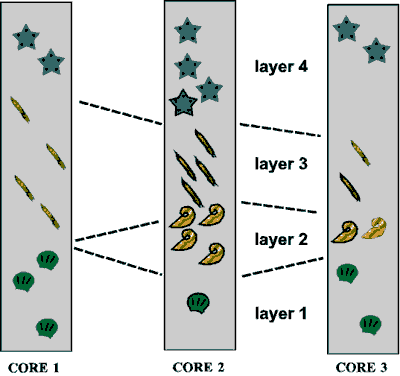BACKGROUND:
Stratigraphy is the study of the physical and time order of rock layers.
In this lab the students will look at sediment cores from wells. They will
learn how geologists "correlate" or match up the different rock
layers from well to well.
The sediment layers in the well cores contain fossils. The fossils change
upward through the cores. These changes occurred as the organisms evolved.
The fossils thus uniquely record the passage of time, because evolution goes
in only one direction. This is called "the Principle of Faunal
Succession". When a paleontologist see certain fossils in a sample, he
or she can deduce the age of the sample.
Fossils and the Principle of Faunal Succession can also be used to
correlate isolated rock outcrops or well cores. If the same fossils or
succession of fossils are seen in different cores, a geologist can deduce
that the cores are the same age.
This lab will illustrate how geologists study strata to date and
correlate rocks. Key characteristics of the fossils will help students
recognize the strata that represent the same interval.
PROCEDURE:
 Before lab you can make a set of cores that resembles the diagram in
exercise 1. However you should make at least 4 different sets of 4
cores, so the students can look and correlated different examples. You
can make permanent cores by using plaster of Paris and embedding real or
fake fossils or shells. Make sure the cores make sense if you line them
next to each other. You also may want the students to make their own
cores by using clay or styrofoam. There are many ways to illustration
correlation of fossils.
Before lab you can make a set of cores that resembles the diagram in
exercise 1. However you should make at least 4 different sets of 4
cores, so the students can look and correlated different examples. You
can make permanent cores by using plaster of Paris and embedding real or
fake fossils or shells. Make sure the cores make sense if you line them
next to each other. You also may want the students to make their own
cores by using clay or styrofoam. There are many ways to illustration
correlation of fossils.
- Have the students complete Exercise 1. They should easily be able to
correlate the fossils between the cartoon cores. Answers are to the
right.
- Draw the following diagram on the board so the students can visualize
where the cores were drilled

- Begin Exercise 2. On their lab sheets, have the students describe the
key characteristics the fossils in each well core. It is crucial that
they be able to identify the fossils before they attempt the
correlations.
- Have the students compare the different sequences between wells and
try to correlate them using the fossils. Each correlated layer
represents the same time at a different place on the Earth’s surface.